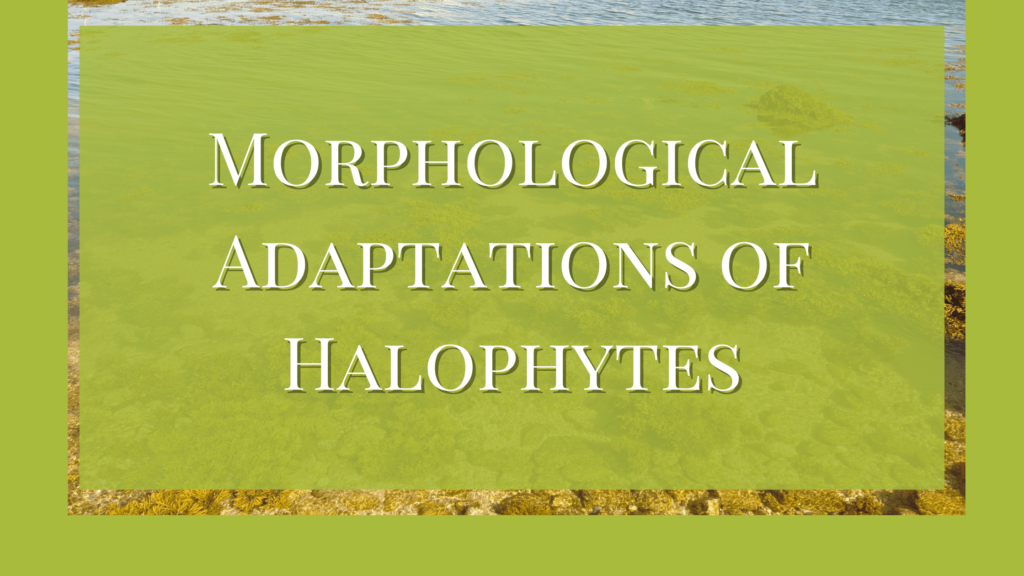Halophytes are plants that live in salt water having high salt content. These plants can survive, prefer, adapt, or complete their life cycles in saline habitats. The adaptations of halophytes help them survive in conditions that are otherwise impossible for most plants.
Halophytes are usually seen near the coast and estuaries. They grow in habitats where other plants are usually unable to. Halophytes can absorb these salts through their leaves and later expel them through their pores and trichomes. They constitute about 1-3% of the total plant population in the world.
Depending on their habitats, halophytes can be hydrohalophytes or xerohalophytes. Halophytes that grow in wet marshy areas are called hydrohalophytes. Those growing in dry saline soil are called xerohalophytes.
Adaptations Of Halophytes
Halophytes have different adaptive features that help them survive these conditions.
Root adaptations
- The aerial branches of halophytes develop prop roots for anchorage in muddy and loose soil. They can penetrate deeper for water absorption. Such prop roots are also called stilt roots and can be strong as well as extensive.
- Some halophytes have poorly developed prop roots while others may entirely lack them.
- Adventitious buttress roots arising from the basal parts of tree trunks provide support.
- Hydrohalophytes have negatively geotropic roots called pneumatophores or breathing roots to facilitate aeration.
- The submerged soil in the coastal regions has poor aeration due to waterlogging. These pneumatophores help compensate for this condition. They arise from the underground roots and project on the surface as peg-like forms with pointed tips.
- Pneumathodes have several lenticels and aerenchyma for gaseous exchange.
- Some halophytes have knee-like structures arising from horizontal roots that can bend downwards to grow deeper in mud. The aerial parts of these structures facilitate gaseous exchange.
- Halophytes that lack pneumatophores have stilt roots to help with aeration.
Stem Adaptations
Halophytes such as Suaede and Salicornia develop succulence depending on the ratio of free ions absorbed. The accumulation of ions induces succulence. The cells will be reduced in number but grow larger in size.
The development of succulence is an indication of its tolerance to saline water. However, submerged marine angiosperms do not develop succulence.
Temperate halophytes are herbaceous while tropical halophytes are bushy in nature.
Leaf Adaptations
- The entire leaves of halophytes become thick and succulent.
- They will be smaller in size and glassy in appearance.
- Some halophytes are aphyllous- without leaves.
- Aerohalophytes develop densely covered trichomes.
- The submerged marine halo[hytes will have poorly developed vascular bundles in their leaves.
- The green-colored epidermis of leaves can absorb nutrients and water directly.
Adaptations of Fruits and Seeds
- Both fruits and seeds are lightweight with air chambers to help them float on water.
- Seed dispersal of halophytes is through water and they need to float for longer to reach their destination.
- The fruits of halophytes are not sclerified.
- They have parenchymatous pericarp and double-layered tests inside.
- Seeds show viviparous germination which means, the seeds would still be attached to the fruits when they are germinating. This allows the seeds to find an anchorage for germination. It continues to grow until the seedling stage. When the seedling finds a suitable substrate to grow, it gets detached from the fruit and becomes independent.
References
- Shukla, R.S. and Chandel, P.S. (2001) Plant Ecology. S. Chand and Company Ltd., New Delhi.
- Verma, P.S., Agarwal, V.K. (1999). Cell Biology Genetics Molecular Biology Evolution and Ecology. New Delhi: S.Chand Co.(Pvt) Ltd.
- Adaptation of Halophytes to Different Habitats
- Butnik, A.A., Japakova, U.N., Begbaeva, G.F. (2001). Halophytes: Structure and Adaptation. In: Breckle, SW., Veste, M., Wucherer, W. (eds) Sustainable Land Use in Deserts. Springer, Berlin, Heidelberg. https://doi.org/10.1007/978-3-642-59560-8_15




